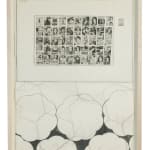
Alighiero Boetti Italian, 1940-1994
Epoca, 1979
Collage and mixed media on paper
48 x 36 cm; (18 7/8 x 14 1/8 in.)
Further images
Alighiero Boetti's Epoca, 1979, stands as a testament to the artist's engagement with time, media, and the intricacies of human perception. Comprising two distinct yet interrelated panels, this work encapsulates...
Alighiero Boetti's Epoca, 1979, stands as a testament to the artist's engagement with time, media, and the intricacies of human perception. Comprising two distinct yet interrelated panels, this work encapsulates Boetti's exploration of the ephemeral nature of news and the enduring qualities of handcrafted artistry. In the upper section, Boetti meticulously recreates fifty covers of Epoca magazine, an Italian weekly published between 1950 and 1997 in Milan. Modelled after Life magazine, Epoca was Italy's inaugural publication to feature illustrations, offering insights into contemporary affairs, and international events, with a particular emphasis on Hollywood. Notably, it was recognised for its conservative stance, anti-communist sentiments, and pro-Americanism, receiving backing from the Italian government during the early 1950s.
Boetti's choice to hand-draw these covers in pencil introduces a deliberate contrast between the transient, mass-produced nature of periodicals and the enduring, personal touch of manual creation. This juxtaposition invites viewers to reflect on the fleetingness of news cycles against the permanence imbued by the artist's labour-intensive process. The monochromatic pencil renderings, susceptible to human error, stand in stark opposition to the vibrant, glossy aesthetics of the original magazines, further emphasising this dichotomy.
The lower panel features a continuous motif of interlocking, biomorphic floral patterns, executed in ballpoint pen. The intricate design, filling the negative spaces, evokes a sense of architectural sketching, blending organic forms with structural precision. This pattern not only complements the upper panel but also reinforces Boetti's fascination with repetition, variation, and the passage of time.
Boetti's oeuvre consistently interrogates how images accrue meaning as contexts evolve. He posited that the significance of a date, for instance, amplifies as time progresses: “Do you know why dates are important? Because...if you write '1970' for example on a wall, it looks like nothing much, nothing at all, but in thirty years' time...With every day that goes by, this date becomes more beautiful. It's time that works, it's all that works.” Epoca embodies this philosophy, transforming ephemeral media into enduring art, prompting contemplation on memory, history, and the relentless march of time.
Created during a pivotal period when Boetti shifted focus to studio-based practices, Epoca exemplifies his innovative approach to materials and techniques. From 1978 until his death in 1994, he delved into various methods such as tracing, drawing, spray painting, stamping, and wordplay. This piece offers a window into his conceptual inquiries and creative processes, highlighting his ability to merge meticulous craftsmanship with profound philosophical musings.
In Epoca, Boetti not only captures a moment in media history but also challenges viewers to consider the transient versus the eternal, the manufactured versus the handcrafted, and the collective versus the individual. It is a work that resonates with timeless relevance, encouraging reflection on how we consume, perceive, and immortalise the world around us.
Boetti's choice to hand-draw these covers in pencil introduces a deliberate contrast between the transient, mass-produced nature of periodicals and the enduring, personal touch of manual creation. This juxtaposition invites viewers to reflect on the fleetingness of news cycles against the permanence imbued by the artist's labour-intensive process. The monochromatic pencil renderings, susceptible to human error, stand in stark opposition to the vibrant, glossy aesthetics of the original magazines, further emphasising this dichotomy.
The lower panel features a continuous motif of interlocking, biomorphic floral patterns, executed in ballpoint pen. The intricate design, filling the negative spaces, evokes a sense of architectural sketching, blending organic forms with structural precision. This pattern not only complements the upper panel but also reinforces Boetti's fascination with repetition, variation, and the passage of time.
Boetti's oeuvre consistently interrogates how images accrue meaning as contexts evolve. He posited that the significance of a date, for instance, amplifies as time progresses: “Do you know why dates are important? Because...if you write '1970' for example on a wall, it looks like nothing much, nothing at all, but in thirty years' time...With every day that goes by, this date becomes more beautiful. It's time that works, it's all that works.” Epoca embodies this philosophy, transforming ephemeral media into enduring art, prompting contemplation on memory, history, and the relentless march of time.
Created during a pivotal period when Boetti shifted focus to studio-based practices, Epoca exemplifies his innovative approach to materials and techniques. From 1978 until his death in 1994, he delved into various methods such as tracing, drawing, spray painting, stamping, and wordplay. This piece offers a window into his conceptual inquiries and creative processes, highlighting his ability to merge meticulous craftsmanship with profound philosophical musings.
In Epoca, Boetti not only captures a moment in media history but also challenges viewers to consider the transient versus the eternal, the manufactured versus the handcrafted, and the collective versus the individual. It is a work that resonates with timeless relevance, encouraging reflection on how we consume, perceive, and immortalise the world around us.
